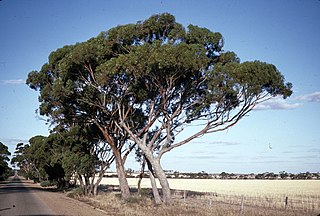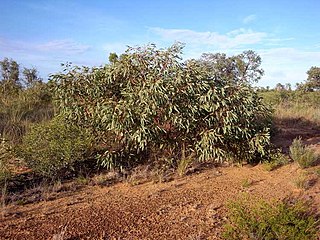
Eucalyptus smithii, commonly known as the gully gum, gully peppermint, blackbutt peppermint, or ironbark peppermint, is a species of medium-sized to tall tree, sometimes a mallee, that is endemic to southeastern Australia. It has rough, compact bark on the trunk, smooth ribbony bark above, narrow lance-shaped adult leaves, flower buds in groups of seven, white flowers and cup-shaped, bell-shaped or hemispherical fruit.

Eucalyptus kartzoffiana, commonly known as the Araluen gum, is a species of medium-sized tree that is endemic to a small area of southeastern New South Wales. It has rough, fibrous or flaky bark on part or most of its trunk, lance-shaped or curved adult leaves, flower buds in groups of three, white flowers and sessile, bell-shaped fruit.

Eucalyptus bridgesiana, commonly known as apple box, apple, apple gum or but-but, is a medium to large sized tree. It has rough, fibrous bark on the trunk and larger branches, smooth grey bark above, glossy green, lance-shaped adult leaves, flower buds in groups of seven, white flowers and hemispherical fruit.
Eucalyptus × alpina, commonly known as Grampians gum, is a mallee or small tree that is endemic to the Grampians in Victoria, Australia. It has fibrous grey bark near its base and smooth greyish bark higher up. The leaves are broadly lance-shaped to egg-shaped and the plant has very warty buds and fruit. There is disagreement about its name, the Royal Botanic Gardens Victoria referring to it as the Mt Abrupt stringybark.

Eucalyptus serraensis, commonly known as the Grampians stringybark, is a species of small tree or mallee that is endemic to the Grampians in Victoria, Australia. It has rough, stringy, fibrous or flaky bark on the trunk and sometimes also the branches, smooth bark above, lance-shaped to egg-shaped or round adult leaves, sessile flower buds in groups of three or seven, white flowers and hemispherical or cup-shaped fruit.

Eucalyptus albopurpurea, commonly known as the purple-flowered mallee box or Port Lincoln mallee, is a mallee or sometimes a tree that is endemic to South Australia. It has loose, fibrous grey-brown bark on the lower park of the trunk and smooth grey bark that is shed in strips on its upper parts. The leaves are lance-shaped to egg-shaped, the flower buds are spindle-shaped to club-shaped and the flowers are white, pink, mauve or purple. Flowering can occur in most months and the fruit are cup-shaped or barrel-shaped capsules.

Eucalyptus griffithsii, commonly known as Griffith's grey gum, is a species of mallee or tree that is endemic to Western Australia. It has smooth grey to whitish bark, sometimes with rough, loose fibrous bark near the base of the trunk, lance-shaped adult leaves, flower buds in groups of three, white flowers and conical to cup-shaped fruit.
Eucalyptus laevis is a species of mallee or tree that is endemic to Western Australia. It has thin, rough, fibrous or flaky bark on the trunk, smooth bark above. Its adult leaves are linear to narrow lance-shaped, the flower buds are arranged in groups of between seven and eleven, the flowers are white and the fruit is cylindrical to barrel-shaped.

Eucalyptus platycorys, commonly known as Boorabbin mallee, is a species of mallee, rarely a small tree, that is endemic to Western Australia. It has rough, dark grey, fibrous and flaky bark on the trunk, smooth greyish bark above, lance-shaped adult leaves, flower buds usually in group of three, creamy white flowers and cup-shaped to cylindrical fruit.
Eucalyptus pruiniramis, commonly known as Jingymia gum or midlands gum is a species of mallee or tree that is endemic to a small area of Western Australia. It usually has rough bark on the lower half of the trunk, smooth bark above, dull green, lance-shaped adult leaves, flower buds in groups of between seven and eleven, white flowers and cylindrical to cup-shaped fruit.
Eucalyptus semota, commonly known as marymia mallee, is a species of mallee or small tree that is endemic to a small area in central Western Australia. It has rough, flaky to fibrous bark on the trunk, smooth grey or brown bark above, linear to narrow lance-shaped leaves, flower buds in groups of seven or nine, white flowers and conical to cup-shaped fruit.

Eucalyptus striaticalyx, commonly known as Cue York gum or kopi gum, is a species of tree or mallee that is endemic to Western Australia. It has thick, rough, fibrous bark on the trunk and larger branches, lance-shaped adult leaves, flower buds in groups of between seven and thirteen, creamy white flowers and conical to cup-shaped fruit.

Eucalyptus falciformis, commonly known as the Grampians peppermint or western peppermint, is a species of tree or mallee that is endemic to south eastern Australia. It has smooth bark, sometimes with rough, fibrous bark at the base, narrow lance-shaped to egg-shaped or curved adult leaves, flower buds in groups of eleven to twenty one, white flowers and cup-shaped to shortly cylindrical fruit.

Eucalyptus aequioperta, commonly known as the Welcome Hill gum, is a mallee, sometimes a tree and is endemic to Western Australia. It has rough bark on the lower half of the trunk, lance-shaped leaves, flower buds in groups of between seven and fifteen, white flowers and more or less cup-shaped fruit.

Eucalyptus ammophila, commonly known as the sandplain red gum, is a mallee that is endemic to central and southern Queensland. It has rough fibrous bark near the base and smooth greyish and orange to bronze bark higher up. It has lance-shaped leaves, yellow or creamy flower buds in groups of between seven and eleven, white flowers and hemispherical fruit with strongly raised valves.

Eucalyptus corrugata, also known as rough fruited mallee or rib-fruited mallee, is a species of tree or mallee that is endemic to Western Australia. It has rough scaly or fibrous bark on the lower part of its trunk, smooth bark above, glossy, lance-shaped adult leaves, prominently corrugated flower buds arranged in groups of three in leaf axils and ribbed, conical to cup-shaped fruit.
Eucalyptus filiformis is a species of mallee that is endemic to a small area on the side of a mountain in Victoria, Australia. It has rough fibrous or flaky bark on the trunk, smooth bark above, narrow lance-shaped to narrow elliptical adult leaves, flower buds usually in groups of seven, white flowers and barrel-shaped fruit.
Eucalyptus hawkeri is a species of mallee or slender tree that is endemic to Victoria, Australia. It has rough, flaky or fibrous bark on the lower trunk, smooth bark above, lance-shaped or curved adult leaves, flower buds in groups of between seven and eleven, white flowers and cylindrical or barrel-shaped fruit.

Eucalyptus neglecta, commonly known as Omeo gum, is a species of small tree that is endemic to a small area of Victoria, Australia. Older plants have rough, fibrous bark on the trunk, otherwise smooth grey to brownish bark, a crown of mostly lance-shaped, egg-shaped or oblong leaves arranged in opposite pairs, flower buds in groups of between seven and fifteen, white flowers and cup-shaped or conical fruit.
Eucalyptus silvestris is a species of mallee or small tree that is endemic to Victoria, Australia. It has rough, fibrous or flaky bark on the trunk and larger branches, smooth greyish brown bark above, glossy green, lance-shaped leaves, flower buds usually in groups of seven, white flowers and conical to cup-shaped fruit.














